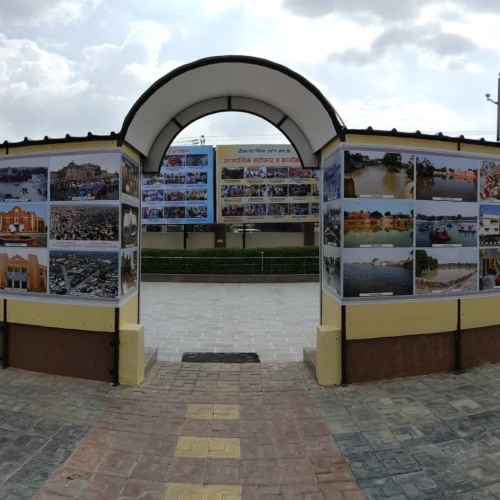BY DEFENCE JOURNALIST SAHIL | T.I.N. NETWORK
Pakistan’s PRSC HS-1 Satellite Launch: A New Hyperspectral Era Begins — Strategic Implications for South Asia and India’s Space Edge
Beijing / Islamabad / New Delhi —
In a significant leap for Pakistan’s space and surveillance capabilities, the country has successfully launched its first hyperspectral Earth observation satellite, PRSC HS-1, marking what analysts describe as the dawn of a new “data-driven security age” in South Asia.
The launch, conducted from China’s Jiuquan Satellite Launch Centre using a Kinetica-1 solid-fuel rocket, positions Pakistan among a small group of nations with hyperspectral imaging (HSI) technology — an elite list that includes the United States, China, Japan, and India.
While Islamabad hails this mission as a scientific and technological breakthrough, experts in New Delhi are closely assessing its strategic undercurrents, particularly given the growing China-Pakistan nexus in space and surveillance domains.
From Remote Sensing to Hyperspectral Vision: Pakistan’s Technological Leap
The PRSC HS-1, developed under the supervision of SUPARCO (Space and Upper Atmosphere Research Commission), is designed to collect data across hundreds of spectral bands, providing detailed insights into Earth’s surface composition. Unlike conventional optical satellites that capture only red, green, and blue (RGB) bands, hyperspectral satellites act as “MRI scanners for the planet,” revealing otherwise invisible patterns in soil, vegetation, minerals, water, and even camouflaged objects.
For Pakistan, this technology could revolutionize multiple sectors — from agriculture monitoring, water management, and urban planning to strategic intelligence gathering. However, it’s the dual-use potential of this system that raises eyebrows in India’s strategic circles.
Defence analysts believe that such high-resolution hyperspectral data could enhance cross-border reconnaissance, helping identify camouflaged installations, missile sites, troop concentrations, and changes in terrain or military infrastructure near the Line of Control (LoC) and Western front.
China’s Deep Role: From Launch Partner to Strategic Enabler
The launch is a fresh milestone in the China-Pakistan space partnership, which began with Beijing’s technical support for PRSS-1 (Pakistan Remote Sensing Satellite) in 2018. With PRSC HS-1, that partnership has now evolved into the hyperspectral domain, a capability that even many developed nations are still mastering.
Chinese aerospace conglomerate CASIC (China Aerospace Science and Industry Corporation) not only provided the launch vehicle but also assisted in systems integration, calibration, and orbit insertion.
For Beijing, this partnership serves a dual purpose — consolidating its strategic hold over Pakistan and extending its technological influence across South Asia, including in domains that can directly challenge India’s regional dominance.
The development also complements China’s Belt and Road Initiative (BRI) and its CPEC (China-Pakistan Economic Corridor) projects, now extending beyond land and sea to the space domain, creating what experts are calling the “Space Corridor of the CPEC era**.”
India’s Calculated Response: Vigilance in the Sky
India’s space establishment, led by ISRO, remains far ahead in both capability and innovation — having launched advanced constellations like Cartosat, RISAT, and EMISAT, along with a growing fleet of navigation and communication satellites.
Yet, New Delhi’s security community is treating the Pakistani development as a “strategic alert.”
Indian analysts note that while PRSC HS-1’s resolution and sensor range remain undisclosed, its spectral capabilities could allow Pakistan to detect cross-border environmental and structural variations that were previously inaccessible. Combined with AI-based analytics and Chinese data-processing support, such imagery could provide near-real-time situational awareness.
A senior Indian defence source commented —
“This is less about Pakistan’s independent space rise and more about how deeply China is embedding its surveillance ecosystem into Pakistan’s national grid. From CPEC to PRSC, Beijing is the real enabler.”
SUPARCO’s Resurgence: From Dormancy to Ambition
Founded in 1961 — even before ISRO — SUPARCO was once considered a pioneer in Asian space exploration. Over the decades, however, political instability and resource scarcity crippled its progress.
The successful PRSC HS-1 launch now signals its revival as a capable space agency with ambitions beyond research.
Pakistan’s Minister of Science and Technology described the event as “the rebirth of Pakistan’s space vision,” asserting that future projects will include high-resolution radar satellites, communications constellations, and eventually a domestic launch vehicle.
This revival, however, remains heavily dependent on Chinese assistance — from hardware supply and launch logistics to ground station networking and image analytics.
Strategic Context: Space as the New Frontier of Regional Competition
The launch of PRSC HS-1 underscores the militarization of South Asian space assets, with India, China, and Pakistan now all fielding dual-use Earth observation satellites capable of supporting both civilian and defence operations.
While India’s space programme has always prioritized self-reliance and indigenous innovation, Pakistan’s trajectory is outsourced but accelerating, primarily powered by Chinese design, launch, and data-processing systems.
In the long term, this partnership could evolve into a regional intelligence-sharing arrangement, where China gains real-time access to South Asian imagery, including India’s western and northern regions. This, defence experts caution, could create new surveillance asymmetries and increase the frequency of information-based conflicts.
Civilian Prospects: Beyond Surveillance
Despite its strategic implications, PRSC HS-1 also promises tangible benefits for Pakistan’s civilian sectors.
Its hyperspectral data will support:
- Agriculture — crop yield prediction, pest detection, and irrigation management.
- Water resource tracking — monitoring of sedimentation and pollution.
- Disaster management — assessment of floods, droughts, and earthquakes.
- Urban planning and sustainability — mapping land use and expansion patterns.
- Mineral exploration — identifying resource-rich zones.
SUPARCO has announced that data from the satellite will be shared with universities and research institutions, positioning it as a cornerstone for Pakistan’s “geospatial innovation ecosystem.”
The Symbolism: National Confidence Amid Crisis
For Pakistan — struggling with economic distress, political turbulence, and global credibility concerns — the PRSC HS-1 mission carries psychological and diplomatic weight.
It sends a message to the world that Pakistan, despite internal turmoil, still aspires to be a producer of science and technology rather than merely a consumer.
As one SUPARCO scientist emotionally remarked:
“For years, we looked at the stars and dreamed. Today, one of those dreams is looking back at us — from orbit.”
India-Pakistan-China Triangle: A New Space Equation
With this launch, the India-Pakistan strategic rivalry has extended decisively into outer space — and this time, China sits at the control console.
For India, maintaining its technological edge through ISRO, DRDO, and private-sector partnerships will be crucial in safeguarding its space-based intelligence superiority.
For Pakistan, this marks a symbolic ascent — a claim that it, too, belongs to the elite circle of space-capable nations.
And for China, it’s another successful move in reshaping Asia’s power architecture — not just on land and sea, but now, in orbit.
The Dawn of the Hyperspectral Age
PRSC HS-1 is not merely a satellite — it is a signal, one that echoes across South Asia’s security and scientific corridors.
For Pakistan, it symbolizes rebirth.
For China, influence.
For India, vigilance.
As the hyperspectral eye of Pakistan begins scanning the Earth, South Asia’s space narrative has entered a new, sharper, and strategically complex orbit — one where every pixel can alter perceptions, and every wavelength may hold a geopolitical message.
BY DEFENCE JOURNALIST SAHIL | T.I.N. NETWORK
पाकिस्तान ने लॉन्च किया अपना पहला हाइपरस्पेक्ट्रल सैटेलाइट PRSC HS-1 — चीन की मदद से शुरू हुआ ‘स्पेस कॉरिडोर ऑफ सीपेक एरा’, दक्षिण एशिया में बढ़ी रणनीतिक हलचल और भारत के लिए नया निगरानी चुनौती
बीजिंग / इस्लामाबाद / नई दिल्ली |
पाकिस्तान ने अंतरिक्ष विज्ञान और निगरानी तकनीक के क्षेत्र में एक ऐतिहासिक छलांग लगाते हुए अपने पहले हाइपरस्पेक्ट्रल अर्थ ऑब्जर्वेशन सैटेलाइट PRSC HS-1 का सफल प्रक्षेपण किया है।
चीन के जिउक्वान सैटेलाइट लॉन्च सेंटर से काइनेटिका-1 (Kinetica-1) सॉलिड-फ्यूल रॉकेट के ज़रिए इस उपग्रह को पृथ्वी की कक्षा में स्थापित किया गया, जिससे पाकिस्तान अब उन चुनिंदा देशों की सूची में शामिल हो गया है जिनके पास हाइपरस्पेक्ट्रल इमेजिंग (HSI) जैसी अत्याधुनिक तकनीक मौजूद है — जिनमें अमेरिका, चीन, जापान और भारत जैसे देश शामिल हैं।
इस्लामाबाद ने इसे “वैज्ञानिक और तकनीकी उपलब्धि” बताया है, लेकिन नई दिल्ली के रक्षा और अंतरिक्ष विशेषज्ञ इसे रणनीतिक चेतावनी के रूप में देख रहे हैं, खासतौर पर चीन-पाकिस्तान की बढ़ती साझेदारी को ध्यान में रखते हुए जो अब ज़मीन, समुद्र और सड़कों से आगे अंतरिक्ष तक पहुंच चुकी है।
रिमोट सेंसिंग से हाइपरस्पेक्ट्रल विज़न तक — पाकिस्तान की तकनीकी छलांग
यह उपग्रह पाकिस्तान की अंतरिक्ष एजेंसी SUPARCO (स्पेस एंड अपर एटमॉस्फियर रिसर्च कमीशन) की देखरेख में विकसित किया गया है। PRSC HS-1 पृथ्वी की सतह का विश्लेषण सैकड़ों तरंगदैर्घ्यों (spectral bands) में करने में सक्षम है।
जहाँ सामान्य उपग्रह केवल तीन रंगों — लाल, हरा और नीला (RGB) — में चित्र लेते हैं, वहीं हाइपरस्पेक्ट्रल सेंसर “पृथ्वी का MRI स्कैन” करते हैं, जो मिट्टी, वनस्पति, खनिज, पानी और प्रदूषण तक की सूक्ष्म जानकारी प्रदान करते हैं।
यह तकनीक कृषि, जल प्रबंधन, शहरी नियोजन और पर्यावरण अध्ययन में तो उपयोगी है ही, लेकिन इसका सैन्य और खुफिया महत्व इससे कहीं अधिक गहरा है।
भारतीय रक्षा विशेषज्ञों के अनुसार, यह तकनीक कैमोफ्लाज किए गए सैन्य ठिकानों, मिसाइल लॉन्च साइट्स, सैनिक जमावड़े, और भू-संरचनात्मक बदलावों की पहचान करने में सक्षम है, जिससे पाकिस्तान की सीमापार निगरानी क्षमता में अभूतपूर्व वृद्धि होगी — विशेषकर LoC और पश्चिमी सीमाओं पर।
चीन की भूमिका: लॉन्च पार्टनर से सामरिक संरक्षक तक
यह प्रक्षेपण चीन और पाकिस्तान के बीच अंतरिक्ष साझेदारी के नए युग की शुरुआत का प्रतीक है।
2018 में चीन ने पाकिस्तान को PRSS-1 (Pakistan Remote Sensing Satellite) की तकनीक प्रदान की थी, और अब उसी सहयोग ने हाइपरस्पेक्ट्रल तकनीक का रूप ले लिया है — जिसे कई विकसित राष्ट्र भी पूरी तरह विकसित नहीं कर पाए हैं।
इस परियोजना में चीन की CASIC (चाइना एयरोस्पेस साइंस एंड इंडस्ट्री कॉरपोरेशन) ने लॉन्च वाहन, सिस्टम इंटीग्रेशन, कैलिब्रेशन और ऑर्बिट इंसर्शन तक में सक्रिय सहयोग दिया।
बीजिंग के लिए यह साझेदारी केवल तकनीकी नहीं, बल्कि रणनीतिक प्रभाव विस्तार का माध्यम है।
अब चीन न केवल पाकिस्तान के CPEC (चाइना-पाकिस्तान इकोनॉमिक कॉरिडोर), बंदरगाहों और सड़क नेटवर्क में मौजूद है, बल्कि अब उसने उसकी अंतरिक्ष संरचना (Space Infrastructure) में भी अपनी उपस्थिति दर्ज करा दी है — जिसे विशेषज्ञ अब “CPEC का स्पेस कॉरिडोर (Space Corridor of CPEC)” कह रहे हैं।
भारत की प्रतिक्रिया: आसमान में बढ़ी सतर्कता
भारत की ISRO (Indian Space Research Organisation) पहले से ही सैकड़ों उपग्रहों के नेटवर्क के ज़रिए रिमोट सेंसिंग, नेविगेशन, और सैन्य निगरानी में अग्रणी है।
लेकिन पाकिस्तान की यह छलांग भारत की सुरक्षा एजेंसियों के लिए सतर्कता का संकेत बन गई है।
विशेषज्ञों का मानना है कि PRSC HS-1 की रिज़ॉल्यूशन और सेंसर रेंज का खुलासा नहीं किया गया है, लेकिन इसकी स्पेक्ट्रल क्षमता पाकिस्तान को सीमा पार पर्यावरणीय और संरचनात्मक बदलावों का बारीक डेटा प्रदान कर सकती है।
यदि इसे AI आधारित एनालिटिक्स और चीन की डेटा प्रोसेसिंग क्षमता के साथ जोड़ा जाए, तो पाकिस्तान को लगभग वास्तविक समय (real-time) में खुफिया जानकारी प्राप्त हो सकेगी।
एक वरिष्ठ भारतीय रक्षा अधिकारी ने कहा —
“यह पाकिस्तान की स्वतंत्र तकनीकी उपलब्धि से अधिक चीन की रणनीतिक घुसपैठ का उदाहरण है। CPEC से लेकर PRSC तक, पाकिस्तान के हर महत्वपूर्ण ढांचे में बीजिंग ही मुख्य संचालक है।”
SUPARCO का पुनर्जागरण: ठहराव से महत्वाकांक्षा तक
1961 में स्थापित SUPARCO कभी एशिया की अग्रणी अंतरिक्ष संस्थाओं में गिनी जाती थी — यह भारत की ISRO से भी पहले अस्तित्व में आई थी।
लेकिन राजनीतिक अस्थिरता, धन की कमी और बाहरी निर्भरता ने इसे पीछे धकेल दिया।
PRSC HS-1 के सफल प्रक्षेपण ने अब SUPARCO के पुनर्जन्म की घोषणा कर दी है।
पाकिस्तान के विज्ञान और प्रौद्योगिकी मंत्री ने इसे “Pakistan’s Space Vision का Rebirth” कहा और घोषणा की कि आने वाले वर्षों में पाकिस्तान हाई-रिज़ॉल्यूशन रडार सैटेलाइट, संचार नेटवर्क, और घरेलू लॉन्च व्हीकल (Domestic Launch Vehicle) विकसित करने पर कार्य करेगा।
हालांकि, विशेषज्ञ यह भी मानते हैं कि SUPARCO की यह सफलता अब भी चीन पर भारी निर्भरता के साथ जुड़ी है — चाहे वह हार्डवेयर सप्लाई हो, लॉन्च सुविधा या डेटा विश्लेषण।
रणनीतिक परिप्रेक्ष्य: अंतरिक्ष बना नया युद्धक्षेत्र
PRSC HS-1 का प्रक्षेपण यह दर्शाता है कि दक्षिण एशिया का अंतरिक्ष क्षेत्र अब वैज्ञानिक सहयोग नहीं, बल्कि रणनीतिक प्रतिस्पर्धा का मैदान बन चुका है।
भारत, चीन और पाकिस्तान — तीनों अब ऐसे ड्यूल-यूज़ उपग्रह (Dual-Use Satellites) तैनात कर रहे हैं, जो नागरिक और रक्षा दोनों उद्देश्यों की पूर्ति कर सकते हैं।
भारत की नीति हमेशा स्वदेशी क्षमता और आत्मनिर्भरता पर केंद्रित रही है, जबकि पाकिस्तान की यात्रा पूरी तरह बाहरी सहारे, विशेषकर चीन पर आधारित है।
भविष्य में यह साझेदारी एक इंटेलिजेंस-शेयरिंग नेटवर्क में बदल सकती है, जहाँ चीन को दक्षिण एशिया की इमेजरी — विशेषकर भारत के पश्चिमी और उत्तरी क्षेत्रों की — रीयल टाइम एक्सेस मिल सकेगी।
यह परिदृश्य भारत के लिए रणनीतिक चुनौती और निगरानी असंतुलन का नया रूप बन सकता है।
नागरिक उपयोग: निगरानी से आगे
PRSC HS-1 केवल सामरिक उद्देश्यों तक सीमित नहीं है। पाकिस्तान इसे कई नागरिक क्षेत्रों में भी उपयोग करने की योजना बना रहा है —
- कृषि: फसल स्वास्थ्य, कीट संक्रमण और सिंचाई प्रबंधन।
- जल संसाधन: नदियों में गाद जमाव और प्रदूषण की निगरानी।
- आपदा प्रबंधन: बाढ़, सूखा और भूकंप जैसी आपदाओं के प्रभाव का मूल्यांकन।
- शहरी नियोजन: भूमि उपयोग, जनसंख्या घनत्व और विकास योजनाओं का विश्लेषण।
- खनिज अन्वेषण: संसाधन संपन्न क्षेत्रों की पहचान और विकास।
SUPARCO ने घोषणा की है कि इस उपग्रह से प्राप्त डेटा विश्वविद्यालयों, अनुसंधान संस्थानों और सरकारी एजेंसियों को उपलब्ध कराया जाएगा ताकि पाकिस्तान में रिमोट सेंसिंग और जियोस्पेशियल विश्लेषण के क्षेत्र में नवाचार को बढ़ावा मिल सके।
प्रतीकात्मक महत्व: संकट के बीच आत्मविश्वास
आर्थिक संकट, राजनीतिक अस्थिरता और वैश्विक दबावों से जूझते पाकिस्तान के लिए यह उपलब्धि केवल तकनीकी नहीं बल्कि मनोवैज्ञानिक और कूटनीतिक विजय भी है।
यह उस देश का संदेश है जो वर्षों से अंतरराष्ट्रीय मंचों पर कमजोर अर्थव्यवस्था के कारण पिछड़ा दिखाई देता था — अब वह कह रहा है कि वह विज्ञान और तकनीक का निर्माता बनना चाहता है, उपभोक्ता नहीं।
SUPARCO के एक वरिष्ठ वैज्ञानिक ने भावनात्मक लहजे में कहा —
“दशकों तक हमने तारों की ओर देखा और सपने देखे। आज उन्हीं सपनों में से एक हमें अंतरिक्ष से देख रहा है — डेटा के रूप में।”
भारत-चीन-पाकिस्तान समीकरण: अंतरिक्ष में नया त्रिकोण
PRSC HS-1 के साथ भारत-पाकिस्तान की प्रतिस्पर्धा अब धरती से अंतरिक्ष तक फैल चुकी है — और इस बार कमान चीन के हाथों में है।
भारत के लिए चुनौती है कि वह अपनी तकनीकी बढ़त को बरकरार रखे — ISRO, DRDO और निजी क्षेत्र की साझेदारी के ज़रिए।
पाकिस्तान के लिए यह एक प्रतीकात्मक उन्नति है — यह दिखाने के लिए कि वह भी तकनीकी रूप से सक्षम राष्ट्रों की सूची में शामिल हो गया है।
और चीन के लिए यह एक और कदम है — एशिया की शक्ति संरचना को फिर से परिभाषित करने की दिशा में, अब अंतरिक्ष तक विस्तार के साथ।
निष्कर्ष: हाइपरस्पेक्ट्रल युग की शुरुआत
PRSC HS-1 केवल एक उपग्रह नहीं, बल्कि एक संकेत है —
एक संकेत जो दक्षिण एशिया के सुरक्षा, विज्ञान और शक्ति समीकरणों को नया आकार देने जा रहा है।
पाकिस्तान के लिए यह पुनर्जन्म है,
चीन के लिए यह प्रभाव विस्तार,
और भारत के लिए यह सतर्कता का आह्वान।
जैसे-जैसे यह हाइपरस्पेक्ट्रल नज़र पृथ्वी का सर्वेक्षण शुरू करेगी, दक्षिण एशिया का अंतरिक्ष परिदृश्य अब एक नए, जटिल और रणनीतिक युग में प्रवेश कर चुका है — जहाँ हर पिक्सेल एक कहानी कहेगा, और हर तरंगदैर्घ्य में छिपा होगा एक भूराजनैतिक संदेश।













Add Comment